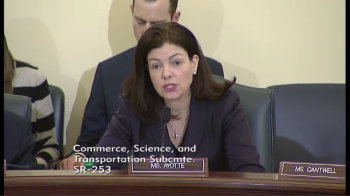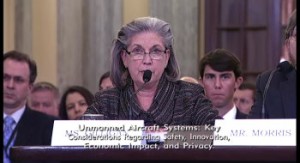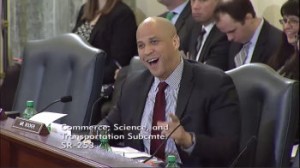A hearing held Tuesday, March 24th, by the U.S. Senate Committee on Commerce, Science, & Transportation focused on the debate over whether unmanned aerial systems (UAS), also known as drones, could be further incorporated into American airspace for commercial purposes. The UAS industry’s inability to satisfy safety and privacy issues regarding drone use were proffered as reasons for slowing down that process but leaders from various industrial sectors worried that America’s slow pace of acceptance was putting it behind drone innovations in other countries.
Drones have enjoyed a growing profile in our collective consciousness thanks in large part to both the incredible array of applications for this technology as well as the concerns over public safety and privacy. Drones can take much of the danger out of work such as utility line inspection or search and rescue missions but their ability to capture images with high-definition cameras has led many to worry about a growth in unwanted snooping by drones. A lack of sense-and-avoid technologies has also fueled fears that a drone doesn’t have the proper safety redundancies to prevent midair collisions that could send heavy objects hurtling out of the sky and onto unsuspecting pedestrians. In mid-February, the U.S. Federal Aviation Administration released a proposed framework of regulations for UAS operation that updated that agency’s rules regarding drones but still kept programs like Amazon Prime air delivery and other beyond line-of-sight operations grounded.
Air safety was on the mind of many of those attending Tuesday’s hearing and both Sen. Kelly Ayotte (R-NH) and Sen. Maria Cantwell (D-WA) both made comments acknowledging that day’s crash of a German Airbus A320 in the French Alps. Both had plenty of positive things to say about the potential of drone use in American airspace. Ayotte noted that greater integration of drones could create thousands of manufacturing jobs as well as billions of dollars in economic development. Cantwell specifically cited the 4,405 worker deaths that occurred in America during 2013 as reported by the U.S. Bureau of Labor Statistics and said that greater UAS integration had the potential to save the lives of those engaged in dangerous work.
Representing the FAA was Margaret Gilligan, an associate administrator with the agency. As she noted, the FAA is still following a five-year roadmap for drone integration established during 2012. The agency is implementing programs such as the “Know Before You Fly” campaign, developed in cooperation with UAS industry partners and designed to educate the public on proper drone use. Gilligan included that a greater degree of commercial facilitation was available through exemptions to certain drone operations that could be granted by the FAA thanks to Section 333 of the FAA’s 2012 reauthorization act; to date, the agency has granted 64 special exemption certificates for work such as aerial filming, agricultural data collection and energy infrastructure inspections. The FAA had issued a total of 176 special airworthiness certificates for civil UAS operation, according to Gilligan, 34 of which were still active at the time of the hearing.
Dr. Gerald Dillingham, director of civil aviation issues for the U.S. Governmental Accountability Office, concretely stated that the economic impact of drone use in America could exceed $82 billion by the year 2025. He noted that the United States lagged behind other countries such as Australia and Canada by a decade or more in terms of issuing drone regulations, but also explained that those countries have less complex airspaces than our nation, which increases the risk of midair collisions here in our country. Dillingham also identified issues in communication between the FAA and the six test sites operating to facilitate research and development of unmanned aerial vehicles, although he noted that those problems in the working relationship seem to have turned a corner thanks to bi-weekly meetings and other measures. Gilligan had previously noted that these test sites were fully operational and that the FAA had developed research agendas for each. As part of the critical next steps forward for the FAA, Dillingham argued that the development of a detailed implementation plan was important for holding the FAA accountable on UAS integration into the airspace.
The lack of greater UAS integration into our nation’s airspace was quite troubling to Paul Misener, vice president of global public policy for Amazon, Inc. Amazon has been a major player in the growing debate about drones thanks to its desire to develop its Amazon Prime Air delivery program, which would deliver online retail purchases to buyers within 30 minutes of their order but would require beyond line-of-sight operation; the FAA has not budged from its position that greater sense-and-avoid technology standards are required for beyond line-of-sight UAS use. Misener was grateful to the FAA for issuing an experimental airworthiness certificate to Amazon during the prior week for further R&D into drone deliveries but called into question the long-term planning of the FAA regarding drones, noting that European countries were developing simple, performance-based frameworks that exceeded the FAA’s current planning activities.
The benefits and importance of unlocking drone use for commercial use were also driven home by Jeff VanderWerff, representing the American Farm Bureau Federation. A farm owner himself, VanderWerff explained the myriad ways in which drones could be part of the solution of improving the efficiency of growing crops while minimizing environmental impacts; drones, he noted, could fly over a field and detect areas to be spot treated with water or fertilizer instead of applying those resources wastefully to an entire field. Drone use, especially beyond line-of-sight use, would greatly reduce the time required to walk and scout out the 3,000 acres of VanderWerff’s farm, which takes 12 hours out of the farm owner’s time every week so he can stay on top of insect infestations or other threats.
Prof. John Villasenor, a non-resident senior fellow at The Brookings Institution, took part in the witness panel to frame the government’s role in protecting privacy with regards to the privacy risks posed by flying high-definition cameras. As for the civil or governmental operation of drones, Villasenor noted that citizen privacy was fairly well protected by the U.S. Constitution. “It’s sometimes suggested that because the Fourth Amendment was ratified over 200 years ago, it will not be effective at providing protections regarding technologies that the founders could scarcely have imagined,” Villasenor said. “In fact, jurisprudence during the 21st century in relationship to other technologies provides cause for optimism.” Specifically, he cited court decisions made against state governments and the federal government in Kyllo v. United States, United States v. Jones and Riley v. California, all of which involved issues of breaching privacy through the use of technology.
In questioning, Sen. Ayotte tried to get Gilligan and Misener to address the balancing of safety concerns and commercial innovation. Misener commended FAA on issuing a notice of proposed rulemaking for small UAS but said that “the fact that we’re not even proposing frameworks for these rules is lamentable.” In response to charges that the United States was trailing European countries and other nations, Gilligan noted that our country has established a much more complex airspace than those nations which generally experience less aviation activities than the United States. Sen. Cantwell asked Gilligan whether the FAA would benefit through the creation of a center of excellence devoted to developing technical solutions to issues raised by drone use, and Gilligan stated that the agency has actually been charged to create one by the end of the year after having received additional funding to do so.
It’s fairly clear that the incorporation of drones into our already complicated airspace would require an even more complex definition of the airways in which aircraft operate throughout this country. Sen. Brian Schatz (D-HI) raised a question over the point at which a landowner ceases to have ownership on the atmosphere above their property, even posing the possibility that an operator could fly a 54-pound drone ten feet above the ground at unregulated speeds. Villasenor noted that the courts should have referendum on this issue as establishing a specific height control could even invite abuse of regulations just for the sake of abusing them.
Privacy issues were the focus of Sen. Ed Markey (D-MA) who, in perhaps the afternoon hearing’s most theatrical gesture, produced a multicolored drone which he described as having two cameras, a retail price of $100 and the capability to spy on unwitting American families. He asked Gilligan whether a private individual could find records on the operations of a drone flying in the airspace over that individual’s property. Although Gilligan noted that it was possible to find out who was operating the drone, the FAA didn’t collect data on why those drones were being operated (although that’s not necessarily accurate given the online information available about Section 333 exemptions issued by the FAA linked above and here). Sen. Steve Daines (R-MT) also fretted over privacy concerns and asked whether local communities could enact measures that regulated non-commercial drone use in states like Montana, where many residents enjoy a great deal of privacy through isolation, a fact Daines himself noted. Gilligan was very wary about state or local regulations affecting the national airspace. “Those people operating broadly in our airspace need to make sure that what they’re doing in one location is consistent with what can occur in other locations,” Gilligan said. In a related but separate privacy issue, VanderWerff raised concerns over the ownership of farm data collected by drones and maintained that regulations should explicitly state language that gives farmers the right to privacy of their data and doesn’t require turning over data to the U.S. Environmental Protection Agency or other third-party groups.
The hearing strongly indicated that the conflict between inadequate sense-and-avoid technologies and standards and the desire to operate drones commercially beyond the line of sight is the major issue that must be solved in order for integration to move forward. Without beyond line-of-sight operations, VanderWerff noted that farmers in the western portions of the United States would have an advantage over eastern U.S. farmers, who operate in areas with more elevation changes and a greater prevalence of tree lines that could diminish an operator’s line of vision. Field geofencing for restricting a drone’s flight path and redundancy features that return a drone to its starting point when experiencing a failure were brought up by VanderWerff as technologies that could support safe UAS operations. “The technology is there and we believe that we can do it safely and effectively,” he said.
At the start of his time to talk to the witness panel, Sen. Cory Booker (D-NJ) asked a series of rhetorical questions about privacy and safety issues that supported his ideas that any reckless acts being perpetrated were often the responsibility of private individuals and not the result of commercial operations. “We need a distinction between commercial use and private use,” Booker said, adding that he couldn’t believe the slow pace of UAS adoption in our own country. “Amazon was granted an exemption, but we’re still behind in pace and frankly there have been no mishaps.” Still, Gilligan solidified the reticence of the FAA to move too quickly in adoption in responses to questions asked by Sen. Dean Heller (R-NV): “If there was a UAS accident in a populated area, this hearing would be about ‘Why did we authorize this?’” she said.
However, there was optimism to be shared among members of the witness panel as well as the senatorial committee. At one point, Misener commended the FAA for their ability to turn a corner in recent weeks with respect to issuing clearer frameworks, which prompted Booker to respond, “Let the record show that you have sufficiently sucked up to the FAA,” drawing laughter from a good portion of the room. Gilligan herself was very positive regarding the potential use and integration of drones into the nation’s skies, again noting the incredible scope of uses and amazing productivity gains capable through this technology. Although the search continues for adequate sense-and-avoid standards to protect people on the ground, it’s clear that there is consensus among the stakeholders of the UAS and drone debate that it would benefit American productivity and commerce if greater commercial integration can be safely achieved.

![[IPWatchdog Logo]](https://ipwatchdog.com/wp-content/themes/IPWatchdog%20-%202023/assets/images/temp/logo-small@2x.png)




![[Advertisement]](https://ipwatchdog.com/wp-content/uploads/2024/04/Patent-Litigation-Masters-2024-sidebar-early-bird-ends-Apr-21-last-chance-700x500-1.jpg)

![[Advertisement]](https://ipwatchdog.com/wp-content/uploads/2021/12/WEBINAR-336-x-280-px.png)
![[Advertisement]](https://ipwatchdog.com/wp-content/uploads/2021/12/2021-Patent-Practice-on-Demand-recorded-Feb-2021-336-x-280.jpg)
![[Advertisement]](https://ipwatchdog.com/wp-content/uploads/2021/12/Ad-4-The-Invent-Patent-System™.png)







Join the Discussion
No comments yet.